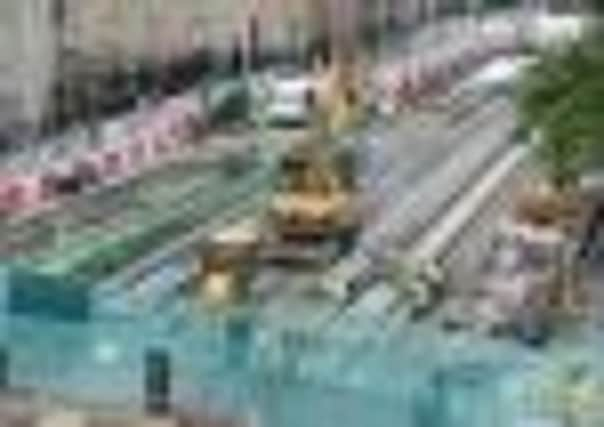Graham Bell: Our vibrant city needs to invest in MORE trams


Here we are with both the Capital’s streets and the citizen’s nerves in tatters. Who would be daft enough to call for more trams? Well, actually the whole exercise makes no sense unless you have a long-term vision and carry it out. Which means more trams. Trams only make sense if there is a network that connects the heart of the city to its main transport conduits and beyond.
Imagine a network that connected Rosyth (or even Dunfermline) to Dalkeith, Livingston to Musselburgh. One that could take you to the new ERI at Little France, or from Granton to the Western General or through Leith. One that connected all the poorest parts of the city with its work opportunities, as well as its schools and health services. Remember that modern trams are fast, comfortable and quiet. In themselves they are pollution free and, because they are powered by electricity, they can be driven from low carbon generation sources.
Advertisement
Hide AdAdvertisement
Hide AdScotland has a fantastic engineering history, but today we are surviving on its remnants. We are trying to run the Capital on what is basically a Victorian infrastructure. To compete on a global stage, and leave a city fit for purpose for our grandchildren, we need to reinvent how we do business, and nowhere more obviously than in how we travel. Yet it seems that attempts to build anything new instantly attract a wall of criticism.
Despite the present debacle in constructing the first phase of the tram, Edinburgh remains a jewel amongst cities – economic powerhouse, vibrant culture, great places to eat and be entertained, and great architecture. Consequently it’s a sought-after visitor destination, but increasingly visitors are unimpressed. Not just by the seemingly endless construction the tram entails, but by potholed roads, uneven pavements, crowded street furniture and a certain careworn edge to this magnificent city.
Visions are not won by listing and amplifying objections. They come from answering the question “how?” If something is desirable, reciting “why not?” doesn’t ever get you there. Endless cost-benefit analyses won’t take us there either. None of the Victorian railway lines ever made a profit, but they transformed our ability as a nation and how we were able to function.
The arguments for need to be considered. When this process started, Princes Street was the most heavily polluted part of the city thanks to an eternal traffic jam of buses. Buses use diesel which in a perfectly tuned engine is a clean fuel. As soon as there is wear and tear then diesels generate carcinogenic particulate matter. In a busy bus fleet you can’t have perfectly maintained engines on all buses. We need buses, and cleaner ones are coming on stream.
Advertisement
Hide AdAdvertisement
Hide AdClean electric trams take more people faster. The need for low carbon is rapidly accelerating and installing the transport systems we need now is surely a sensible idea. On high-volume, fast-track routes, trams excel.
City centre construction has been a nightmare as all the underground services have had to be moved sideways and replaced. The further you get from the city centre, the less dense the pipework is and the easier the task becomes. The good people of Leith have already endured this process down to Ocean Terminal, so that should be the next leg of the system.
There are some caveats to all of this. Firstly, if we were to construct concrete conduits under or major streets – say two metres diameter – and run all services through them, we wouldn’t need to dig the streets up continually to maintain them. Secondly, the city needs to commit to mend all its roads and pavements. If this is a world-class capital then it needs to look like one. Georgian simplicity.
In Dublin, it was not just the benefits of the ride on the finished product that got people demanding more, it was the superb finish along every track that was laid.
Advertisement
Hide AdAdvertisement
Hide AdIf there’s to be more tram track then the stops need to be more frequent where they matter. If you want public support, try home-based contractors and Scottish-built rolling stock. Add on to the project incrementally and get the management right. No-one can endure eternal delays, failures and cost escalations.
Then the big objection – money. That one didn’t stop the Victorians and it shouldn’t stop us now. Which are we – the forgotten empire that got lost, or the vibrant modern Capital that reinvented itself? I know which I’d choose.
• Graham Bell is managing director of Graham Bell Associates, Policy Advisors
Going off the rails
ORIGINAL plans drawn up for the Edinburgh Trams project in 2001 included three routes across the city.
Advertisement
Hide AdAdvertisement
Hide AdAll lines would run through the city centre, but would reach Newbridge to the west, Newhaven and Granton to the north and Little France to the south.
But the line south was scrapped in February 2005 after the council’s congestion charge plans were knocked back in a referendum. A year later, a line linking Haymarket and Granton was shelved due to funding problems.
By June last year plans to take the route as far as Newbridge or Newhaven were on life-support, with the plug being pulled when then-council leader Jenny Dawe’s Lib Dem group won a crucial vote to press ahead with a curtailed tram line from the airport to St Andrew Square.